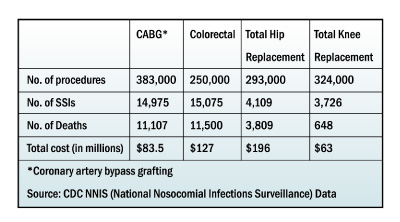 |
 |
 |

July / September 2004

Six Sigma
Reducing Surgical
Site Infections
Through Six Sigma & Change Management

By Carolyn Pexton
and Deborah Young, RN
Hospital-acquired infections represent a significant patient safety concern, causing increased injury, mortality, and healthcare costs. In 2002, the Centers for Medicare & Medicaid Services (CMS) and the Centers for Disease Control and Prevention (CDC) launched a national quality improvement project aimed at reducing the occurrence of postoperative surgical site infections (SSIs).
The CMS/CDC Surgical Infection Prevention Project (SIPP) focused on preventing SSIs by improving the selection and timing of prophylactic antibiotic administration. Five common procedures were targeted: cardiothoracic, vascular, colon, hip or knee replacement, and vaginal or abdominal hysterectomy.


|
 |
 |
 |


















|
 |













